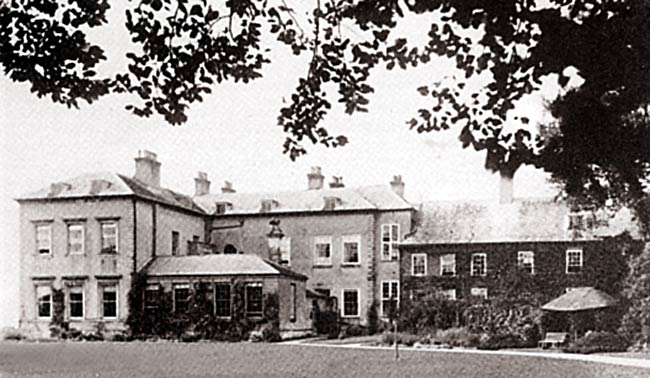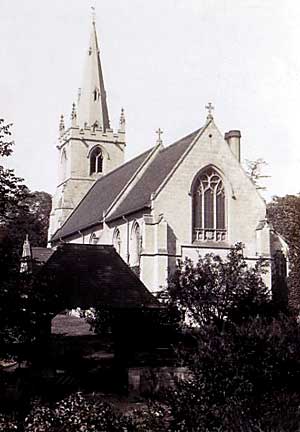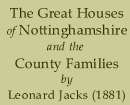< Flintham | Contents | Kelham >
Grove

The south-east view of Grove Hall in the early 20th century. The original Tudor house is on the right.
GROVE originally belonged to Roger de Bush, who was possessed of no fewer than a hundred and seventy-four manors in Nottinghamshire. These were granted to him by William the Conqueror, and Grove and West Retford were amongst the number. In the reign of Henry the Second, the Grove estate passed to Gilbert de Arches, and by marriage it was carried into the de Hercy family in the following reign. With the de Hercys—a family of title, it remained for a great number of years, until Sir John de Hercy granted it to one of his sisters, and co-heiress, who had married Mr. George Neville, of Ragnall. We now find Grove in the possession of the Nevilles, and it so remained until the latter end of the seventeenth century, when Sir Edward Neville sold it to Sir Cresswell Levinz, one of the judges of the Common Pleas. The son of this gentleman, who resided at the Grove after his father’s death, was one of the members for East Retford, and afterwards for the county. Grove continued in the possession of the Levinzs for three generations. In the year 1762, one of the family sold the whole of the estate to Mr. Anthony Eyre, of Rampton, whose family retained it until by marriage, it came into the possession of the Vernons, who reside there now. Piercy, in his history of Retford, says :—" A large brick house in the Old English style with gable ends and mullion windows, had been erected at Grove, at a period which is not known, and had undergone considerable alterations. During the wars between the houses of York and Lancaster, the Hercy family with their neighbours the Stanhopes of Rampton, were active supporters of the House of Lancaster, and during the arduous struggle for superiority were frequently surrounded by dangers of no common kind. Afterwards as a mark of their zeal and as a remembrance of their past services, they each of them inserted in the walls of their respective mansions, a sculptured rose and crown, the device assumed by Henry the Seventh and by many of his adherents. This device was placed in the house at Grove, over a large Gothic window which lighted the principal staircase. Sir Cresswell Levinz and his son made some alterations in the house, and Mr. Eyre, after he purchased it, entirely altered the character of it, removing the whole of the ancient roof, and pulling down a considerable portion of the south-west front, in place of which, under the direction of Mr. Carr, the architect, he built a suite of rooms of handsome and more convenient dimensions. In making this alteration he took down a stone tower, which must have been built in the time of Queen Elizabeth, and under it were found a considerable number of coins of that Queen’s reign."
Grove Hall is one of the best houses in the north of the county; the estate in the midst of which it stands is, from its formation, and from its advantages of richly-wooded park and plantation, one of the most picturesque in the locality. There are some charming places round about Retford, and this is one of them. It is only three miles distant from the ancient borough just named, and is well known to most of the people who live there, not only because it is a large and important house, employing a goodly number of people to do the work of a considerable private establishment, but because the family which has resided there for many, many years has taken a permanent interest in Retford affairs, and has always been looked up to as one possessing more than ordinary influence. The Vernons of Grove are as well known in the north as any of the leading families are in the south, though they have not been so long resident in the county as a number of other families that I could name. They are a branch of a family which has a peer for its head, and whose members have held distinguished places in the Senate and in the Church. One of them was an archbishop of York—Archbishop Harcourt; several of the family have been returned to Parliament by various constituencies. One of them represented the neighbouring borough of Newark from 1852 to 1857. Mr. Granville Harcourt Vernon, who died only a few years ago, and whose bones repose under a spreading sycamore in the quiet churchyard at Grove, represented East Retford in the Whig interest. ‘the modest headstone recording the name of the late lord of Grove and the date of his decease, illustrates one of the leading traits of his character. His life was one of the simplest, his habits were quiet and unobtrusive. But he was a man of the world, and in his time had been looked upon in high quarters with respect and deference. His successor, the gentleman who now owns the important estate of the Vernons in this county, extending over some 4,000 acres at Grove, is Mr. Evelyn Harcourt Vernon, a canon of the Church, the second son of the venerable squire to whom I have just referred. Until he came to the property, Mr. Vernon was rector of Cotgrave, a village largely owned by Lord Manvers; he is now 10th lord and rector of Grove, and in the tiny church near his charming residence he not unfrequently officiates.

Grove Church, c.1920.
The house over which the rector presides is a conspicuous object in a charming landscape. Perhaps its proportions would have been less familiar, if the brickwork of which its walls are composed had not been coated with staring stucco— a piece of questionable taste, for which a former proprietor was responsible. Now it is a white house, dominating in landscape of exquisite beauty. It enjoys a commanding situation, and its front overlooks an expanse of park land which is studded with old and majestic trees, and is green with swelling turf. The view is charming; the eye never tires of it. Eastward lies Lincoln, with its superb minster, the towers of which are visible from here on a clear day; westward are the sturdy oaks, delicate silver birches, and dark pines of Sherwood Forest, and further away you may see the hills of Derbyshire. The immediate neighbourhood is full of interest, for the Romans had a station not far away, and relics of the past have been dug from the fertile soil, upon which everything seems to flourish. In the house one is shown several things which are connected with its early history, and with that of the family to whom the estate originally belonged. In the hail there is a striking portrait of Sir Hardolph Wastanys, the old lord of Headon, not far away, who made Grove his principal residence, and whose great niece was espoused to Mr. Anthony Eyre. At Headon there was once a house of some consequence, but there are no traces of it now. Here, too, is a picture of Sir Gervase Eyre, who was killed at the defence of Newark Castle, and two portraits of Canon Vernon’s ancestors in the costumes of a remote period. In the library are some rare old books, amongst them a very fine copy of the first published edition of Shakespear’s works, with the red edges which stamp its value; and hung upon the walls are engraved portraits of men who were once celebrated in the county and elsewhere—the late Mr. Vernon, Mr. Gaily Knight, Archbishop Harcourt, Sir Hamilton Seymour the diplomat, Lord Carlingford, and others. Several of the rooms in this part of the house were added by the late Mr. Vernon; other parts of it were built in the reigns of Henry VIII. and Queen Anne. On the main staircase there hangs a piece of curious tapestry work, upon which an immense amount of labour has been expended, and upon which wonderful geographical knowledge is displayed. This is a complete map of Nottinghamshire, worked by Miss Mary Eyre, in 1632. The work is still perfect, and the name of every place in the county is marked with accuracy, and in the deftest manner. Formerly the dining room was upstairs; this apartment is now used as a dressing room, and it contains some exquisite carving, believed to be by Gibbons. In one of the principal of the lower rooms are three fine pictures, supposed to be of James II., of the Duchess of Portsmouth, and of Nell Gwyn, and a massive carved sideboard of Venetian origin. The gardens at Grove are famous. They were formed in the year 1798, and at that time they were amongst the finest in the county. Even now they grow marvellously fine flowers and fruit—gloxinias, which for beauty of form and purity of tint, could hardly be surpassed, grapes, which for lusciousness and profusion would bear comparison with the produce of larger and more recently made vineries; and there is a big kitchen garden, set round with rose trees and smart flowers, which make a brave show, and fill the air with perfume.
